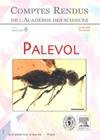Limb histology of the Triassic stem turtles Proterochersis porebensis Szczygielski & Sulej, 2016 and Proganochelys quenstedtii Baur, 1887 with insights into growth patterns of early turtles
IF 1.3
4区 地球科学
Q3 PALEONTOLOGY
引用次数: 0
Abstract
Data on turtle limb bone histology and microstructure are spotty, especially for Mesozoic taxa, despite significant progress made in recent years. Here we provide first detailed information on the stylopodia of the Late Triassic stem turtles Proganochelys quenstedtii Baur, 1887 from Switzerland and Proterochersis porebensis Szczygielski & Sulej, 2016 from Poland. In both taxa we observed large, internal medullary regions filled with endosteal trabeculae and poorly to moderately vascularized parallel-fibered (grading locally to lamellar) periosteal cortices. Primary vasculature is predominantly longitudinal, in Proterochersis porebensis locally with radial inclination. In large specimens, secondary remodeling is significant in the deeper cortex, but it neither completely obliterates the primary tissue nor reaches the external surface of the bone in either taxon. Comparison of histological data, limb morphology, shell and limb lengths as well as proportions reveal differences in growth patterns between the taxa: Proganochelys quenstedtii seems to grow faster during early life stages than Proterochersis porebensis and attained distinctly larger body sizes earlier in ontogeny, even though the asymptotic body size is roughly the same for both species. Overall, the histological and microstructural characteristics of stylopodial bones of Triassic turtles more closely resemble those of more recent representatives of that group than earlier stem turtles.三叠纪干龟Proterochersis porebensis Szczygielski &;Sulej(2016)和Proganochelys(1887)对早期海龟的生长模式进行了深入研究
尽管近年来取得了重大进展,但关于龟肢骨的组织学和微观结构的研究数据却参差不齐,尤其是中生代类群。本文首次对瑞士晚三叠世茎龟Proganochelys quenstedtii Baur, 1887和Proterochersis porebensis Szczygielski &;Sulej, 2016年,波兰。在这两个类群中,我们观察到大的髓内区充满了骨内小梁和血管化程度较低到中等程度的平行纤维骨膜皮质(局部分级为板层)。原生血管主要是纵向的,在多孔性元肝纤维化中,局部呈放射状倾斜。在大型标本中,继发性重塑在较深的皮质中是显著的,但它既不会完全抹掉初级组织,也不会到达骨的外表面。组织数据、肢体形态、壳和肢体长度以及比例的比较揭示了这两个分类群之间生长模式的差异:在生命早期阶段,原螯虾似乎比波氏原螯虾生长得更快,并且在个体发育早期获得了明显更大的体型,尽管这两个物种的渐近体型大致相同。总的来说,三叠纪龟的茎突骨的组织学和微观结构特征比早期的干龟更接近于该群体最近的代表。
本文章由计算机程序翻译,如有差异,请以英文原文为准。
求助全文
约1分钟内获得全文
求助全文
来源期刊

Comptes Rendus Palevol
地学-古生物学
CiteScore
2.10
自引率
0.00%
发文量
39
审稿时长
17.6 weeks
期刊介绍:
Comptes Rendus Palevol is a fully electronic and peer-reviewed journal, with a continuous publication stream, devoted to palaeontology, prehistory and evolutionary sciences. It publishes original research results, in French or English, in the following domains: systematic and human palaeontology, prehistory, evolutionary biology and macroevolution, and history of sciences. Thematic issues may also be published under the responsibility of a guest editor. All articles published in Comptes Rendus Palevol are compliant with the different nomenclatural codes. A copyright assignment will be signed by the authors before publication.
 求助内容:
求助内容: 应助结果提醒方式:
应助结果提醒方式:


